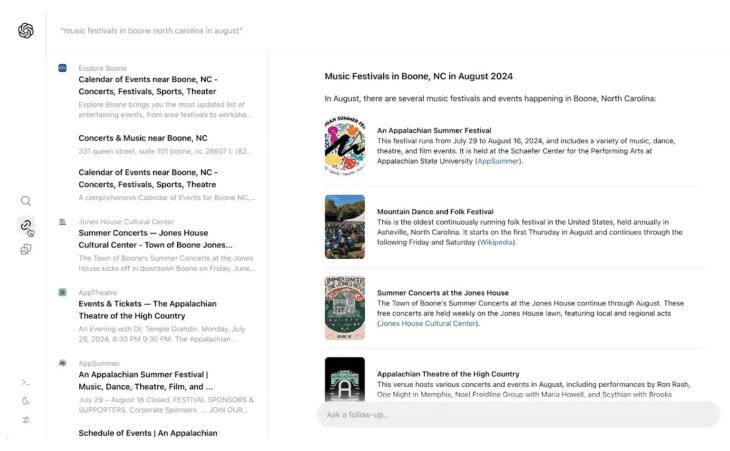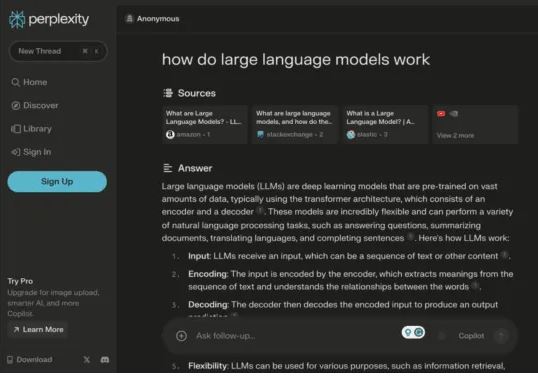SearchGPT vs. Google: Where Should You Focus Your SEO Optimization?
 ITXITPro LLC
ITXITPro LLC
The Rise of AI Search Engines: Is Google's Supremacy in Jeopardy?
OpenAI, the developer of ChatGPT, revealed a prototype search engine based on AI called SearchGPT. The mission? To transform online search by offering more conversational and personalized results, directly challenging Google's dominance for years. Nevertheless, like with any new technology, initial user reviews indicate that SearchGPT is still in the process of being fine-tuned.
With AI transforming online experiences, companies and marketers are now wondering where they should be concentrating their SEO activities. Do they continue with age-old Google SEO tactics, or is it the time to SEO for AI-powered search engines like SearchGPT?
Knowing SearchGPT's Search Capabilities
SearchGPT, which is driven by the newest GPT-4 language models, utilizes sophisticated natural language processing to analyze and answer user questions in a conversational tone. Unlike Google, which is based on keyword optimization, backlinks, and structured data to rank search results, SearchGPT is concerned with context and user intent.

How SearchGPT Provides Search Results
SearchGPT seeks to present direct, summary answers instead of just showing a list of links. It provides contextual summaries and organizes web content effectively, enhancing user experience by providing immediate and relevant responses.
How SearchGPT Works
Now available as a beta prototype, SearchGPT will reportedly be integrated with ChatGPT to conduct real-time web searches. It uses sophisticated AI models that have been trained on large textual datasets, allowing it to examine user input, determine meaning, and create conversational responses.
SE Ranking analyzed a study, which revealed SearchGPT's results are 73% akin to Bing's, while overlapping only 46% with Google (Search Engine Journal, 2024). This change points towards businesses SearchGPT optimizing potentially reaching consumers in ways they might not achieve with traditional Google SEO strategies.

How SearchGPT Is Different from Conventional Search Engines
Whereas Google leads the search engine market by focusing on variables such as backlinks, keywords, and user experience, SearchGPT diverges. It focuses on contextual comprehension and user purpose and supplies strongly customized results that concur with users' individual requirements. This new direction brings with it opportunities as well as challenges for entrepreneurs to deal with the changing SEO terrain.
If you’re looking to optimize your digital presence, understanding SearchGPT’s unique features is crucial.
OAI-SearchBot: The Core of SearchGPT
OAI-SearchBot is SearchGPT’s dedicated content crawler, playing a vital role in its search capabilities. As one of OpenAI’s web crawlers, it executes searches and links to relevant websites in response to user queries. Webmasters can manage how this bot interacts with their site’s content using robots.txt.
Notably, OpenAI has explained that OAI-SearchBot does not scrape website pages for training generative AI models. Nevertheless, some prominent news websites and outlets have blocked the bot for reasons of privacy. Nevertheless, webmasters advise the majority to provide access to guarantee indexing in this new AI-based search engine.
Clear Attribution and Transparency
To promote credibility, OpenAI works with third-party content providers to present updated and accurately sourced information. In contrast to certain AI-based content, SearchGPT provides open-source citation references so that users can verify displayed information by using attributed links.
Real-Time Search Capability
One of SearchGPT's biggest innovations is the retrieval of real-time information. This overcomes one major flaw of AI models such as ChatGPT, which could give out-of-date information. Through live searching, SearchGPT provides users with the latest and most pertinent information available on the internet.
Key Features of SearchGPT's AI-Powered Search Engine
Conversational Interactivity: Users are able to pose follow-up questions to narrow down their search, making the experience dynamic and interactive. This functionality replicates ChatGPT's conversational nature, with queries building upon earlier responses.
Visual Responses: In addition to the usual text-based responses, SearchGPT incorporates AI-created visuals, such as videos, to enhance user experience. Though information on this feature is still scarce, it holds the potential for a more engaging and informative search experience.
Improved Sidebar Navigation: The search engine has a sidebar with extra links and more search options, allowing users to find related content more easily.
Structured and Detailed Responses: In contrast to traditional search engines that only provide lists of links, SearchGPT organizes its responses with brief summaries and descriptions, making the search process easier for users.
With these advancements, SearchGPT is defining the future of searching by emphasizing relevance, interactivity, and transparency—providing an AI-driven alternative to conventional search engines.
SEO Strategies for SearchGPT vs. Google
SEO experts need to change their game plan to make space for AI-powered search engines without losing focus on Google. Here's optimization for each in a nutshell:
Traditional Google SEO
Keyword research, backlinks, and on-page optimization are priorities.
Optimize site speed, user experience, and mobile usability.
Use structured data to optimize search rankings.
Developing SEO for SearchGPT
Develop Conversational Content: Focus on natural language, FAQs, and storytelling as per AI-led searches.
Leverage Schema Markup: Improve content visibility and offer machine-readable structured data.
Include Multimedia Components: AI-driven visuals and interactive content may take precedence over SearchGPT.
Optimize for Contextual Keywords: Unlike optimizing for match-phrase keywords, optimize on intent-based or natural language usage.
Major Differences Between SearchGPT and Google's Algorithm
SearchGPT and Google are used for distinct purposes in the creation of search results. SearchGPT works on conversational AI, responding to user questions and context, while Google works on a complex algorithm that takes into account numerous ranking factors including keywords, backlinks, and user experience. It is vital to understand these differences in order to optimize SEO strategies and optimize content for both platforms.
Result Generation Process
The core distinction between SearchGPT and Google is the manner in which they generate results. SearchGPT uses conversational AI, reading user intent and context to create responses dynamically.
In contrast, Google uses a complex algorithm that assesses a variety of ranking signals, such as backlink authority, keyword relevance, and content quality. This systemized methodology enables Google to deliver authoritative search results, frequently linking to high-authority sources for further learning.
Because of this difference, Google is more likely to provide more specific and organized search results, while SearchGPT gives contextual, conversational answers that are user-inquiry-specific.
Ranking Factors
Google's algorithm considers several ranking factors, including:
Authority and relevance of backlinks
Strategic keyword placement
Mobile-friendliness and overall user experience
These are all crucial for companies seeking to enhance their Google search rankings.
Conversely, SearchGPT focuses on user intent ahead of conventional SEO factors. It is therefore imperative for companies to prioritize conversational, natural language-based content that resonates with user queries and context.
Comparison of Search Results
Take the following example:
A Google search for "best marketing strategies" would return a list of top-ranking SEO-optimized articles prioritizing authoritative sources and organized content.
The same question on SearchGPT could lead to a tailored response, with ongoing trends and site-specific advice derived from conversational AI insights.
This is the main point to note: the necessity for companies to make their content strategy dependent on the platform. In Google's case, search optimization through SEO guidelines continues to be essential, but for SearchGPT, being more context-specific and user-oriented can maximize the impact of content.
The Future of SEO: Do You Need to Change Tactics?
As developing search engines further embrace AI technology, companies ought to pursue both sides: It will be less effective to ignore and more costly to wait it out.
Keep up optimal SEO habits for Google to keep being visible in old-fashioned searches.
Begin optimizing for AI-powered search engines such as SearchGPT by putting priority on conversational content and context relevance.
Though SearchGPT is just emerging, its capacity to revolutionize the search industry is real. Marketers and business leaders who shift their SEO services tactics today will be well suited to excel in the new world of search.
Final Thoughts
SEO isn't merely ranking on Google anymore. With the advent of AI-driven search engines, companies have to change their approach to stay ahead. Opting for either Google, SearchGPT, or both will require companies to remain informed and flexible to remain successful in online marketing in the future.
Subscribe to my newsletter
Read articles from ITXITPro LLC directly inside your inbox. Subscribe to the newsletter, and don't miss out.
Written by

ITXITPro LLC
ITXITPro LLC
ITXITPro LLC offers comprehensive online marketing solutions in the USA, including website design and development, software and mobile app development, and affordable digital marketing services. Specializing in internet marketing solutions and online services marketing, ITXITPro LLC strives to achieve premium results with cost-effective strategies, all under one roof. Our expertise includes top SEO services and Shopify development services, ensuring your business thrives in the rapidly evolving digital landscape. We continually seek innovative ways to develop unique, creative solutions tailored to our clients' needs. Visit our website for more information.